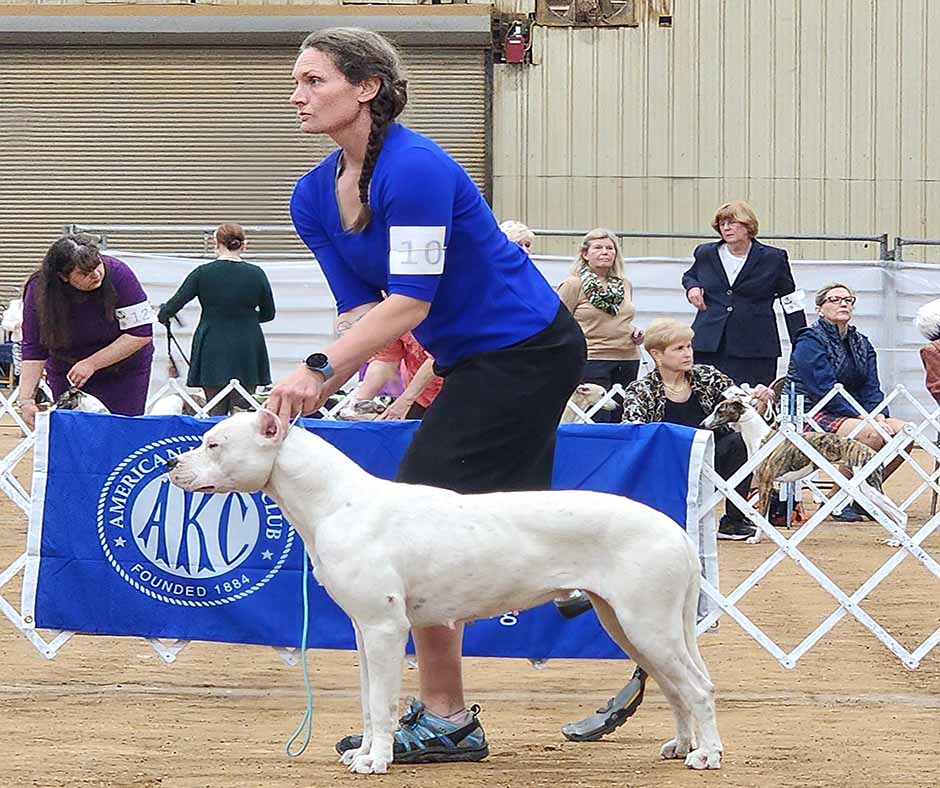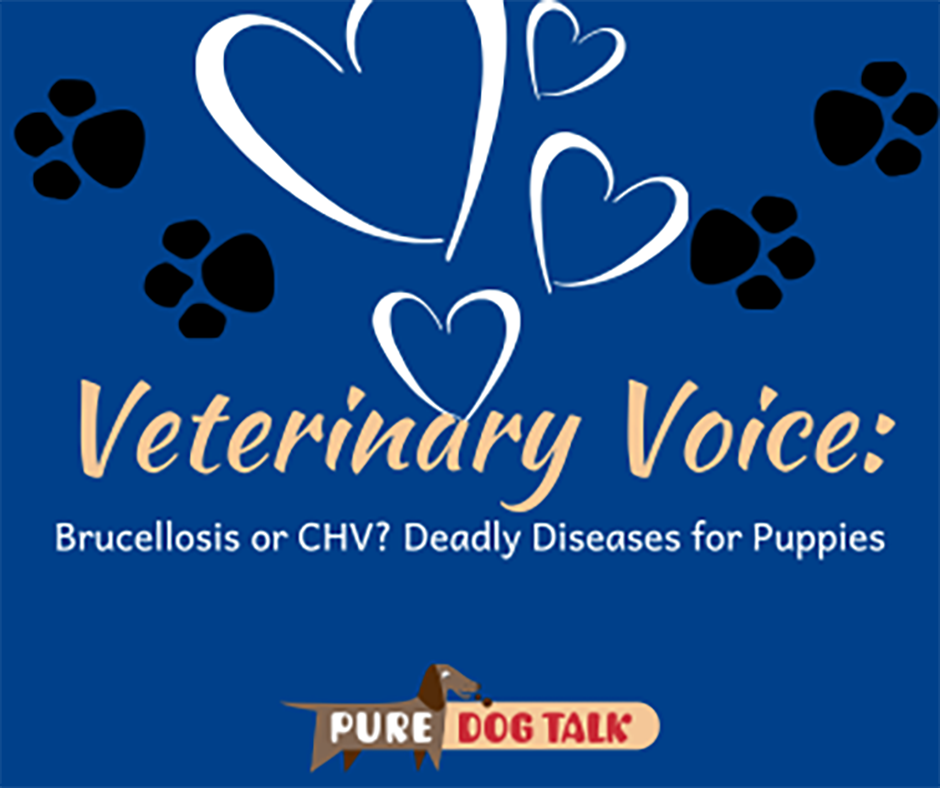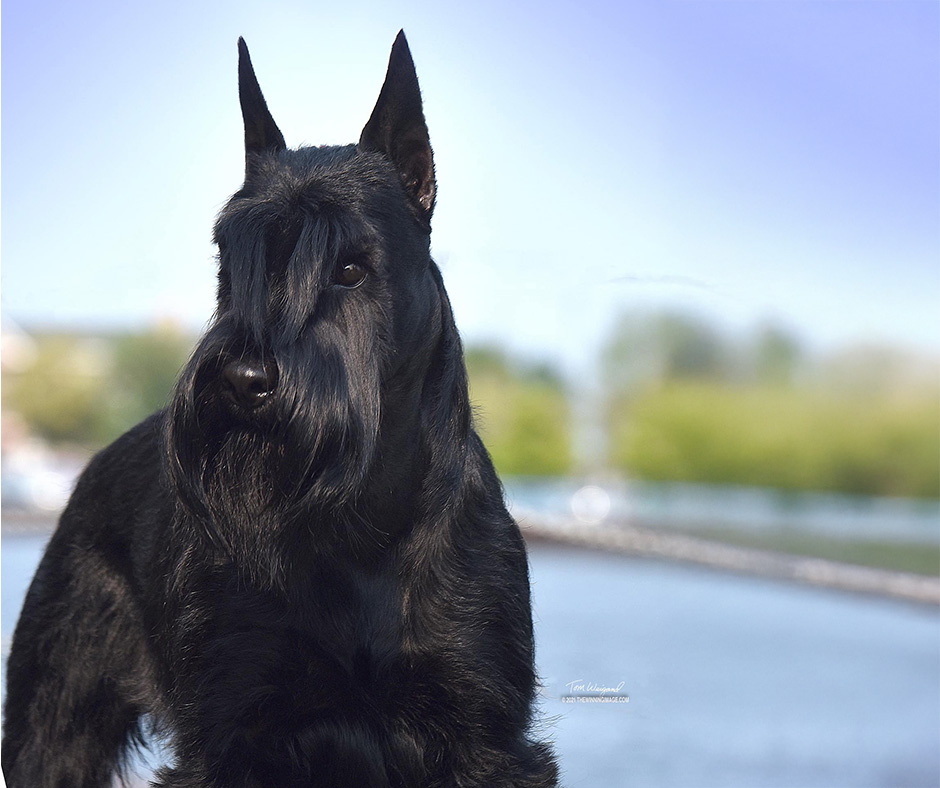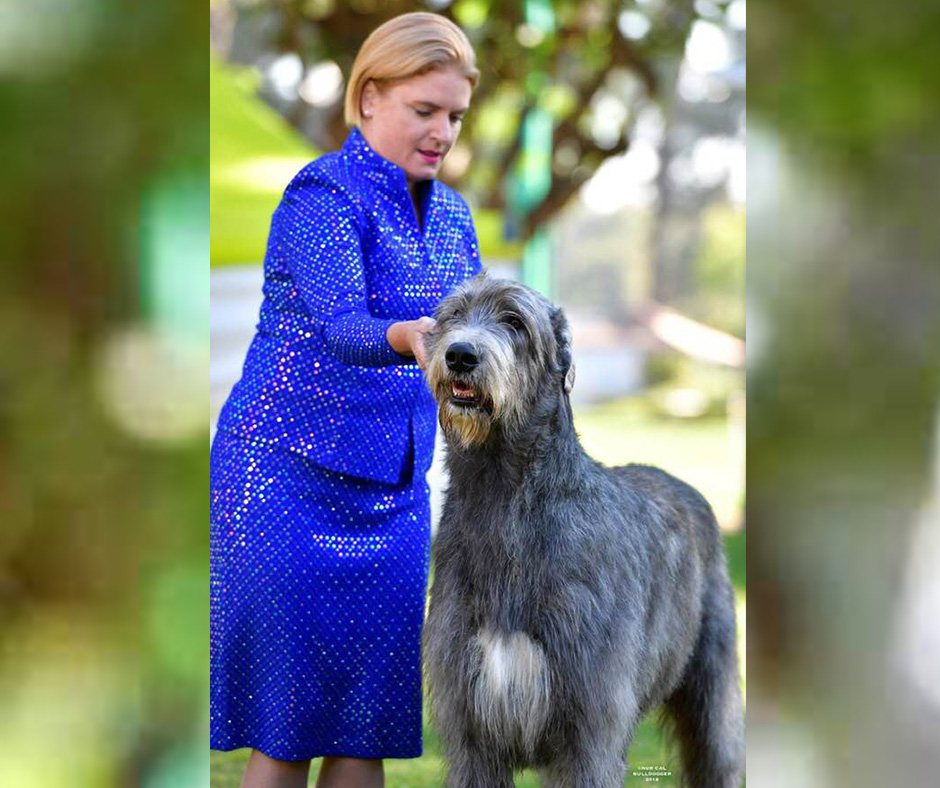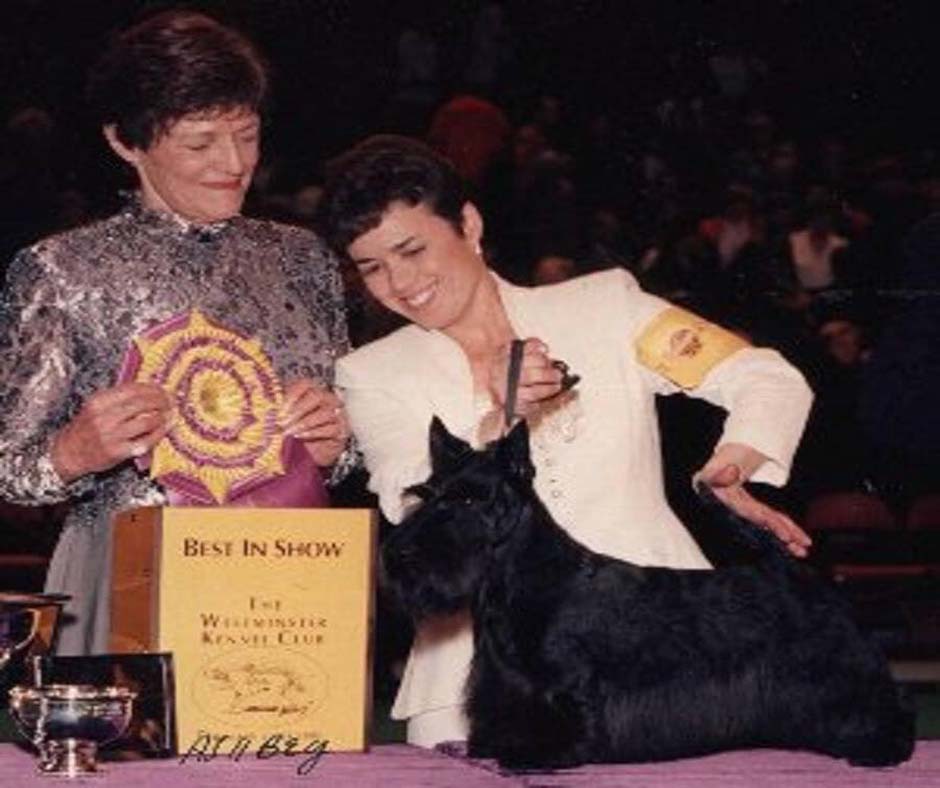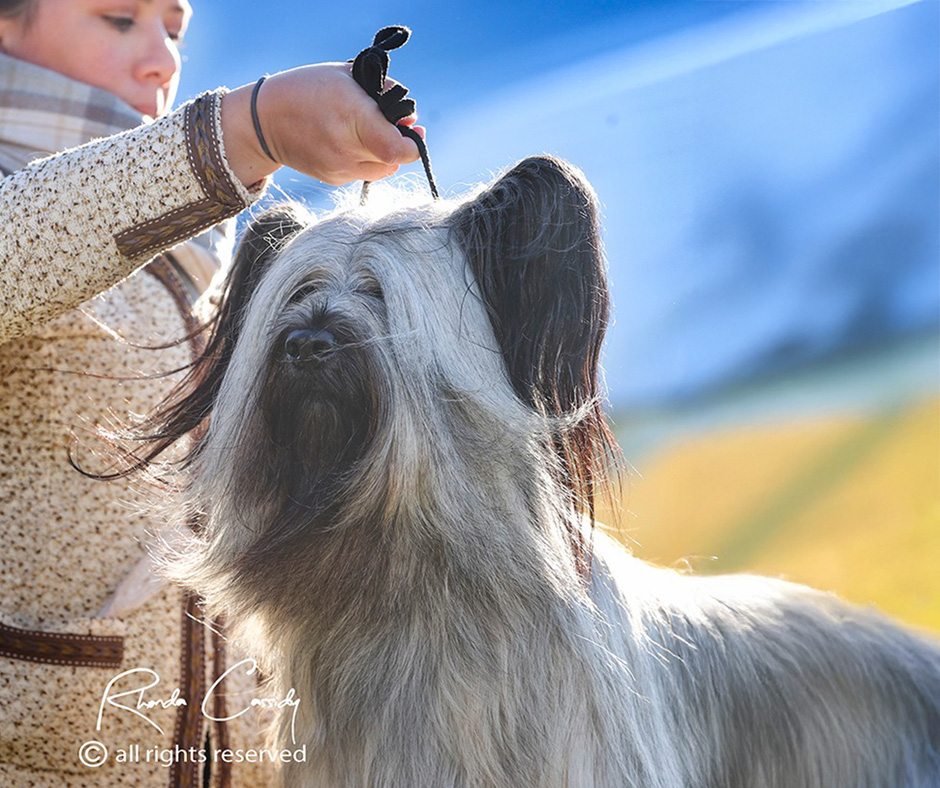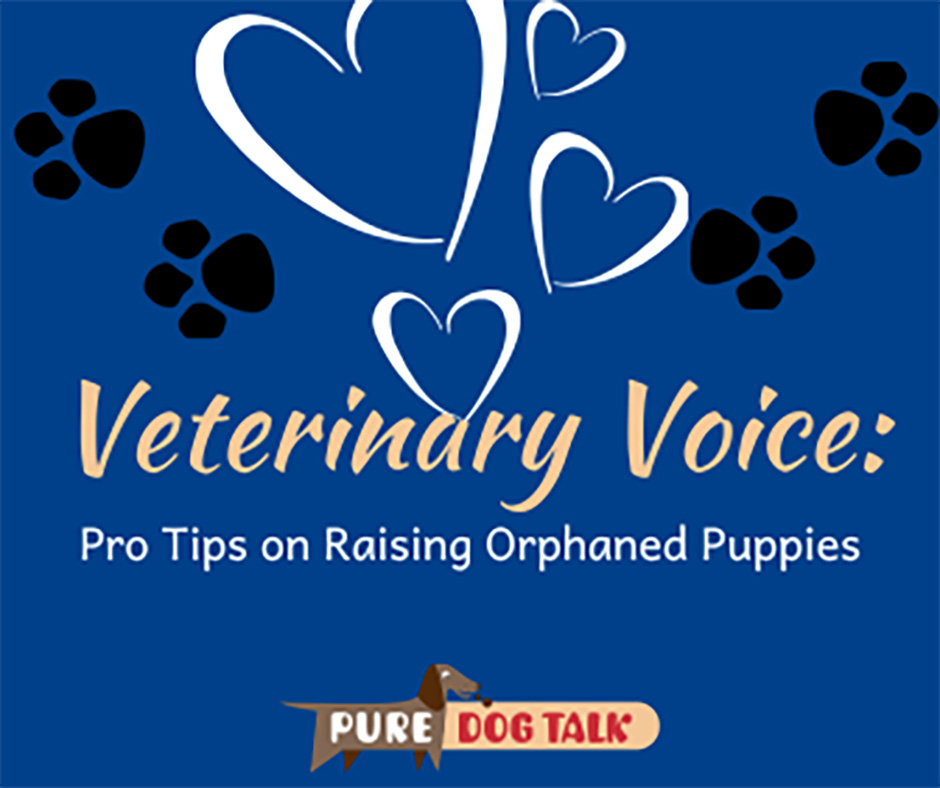Posts by Laura Reeves
677 – Overcoming Obstacles by Giving Grace
Overcoming Obstacles by Giving Grace
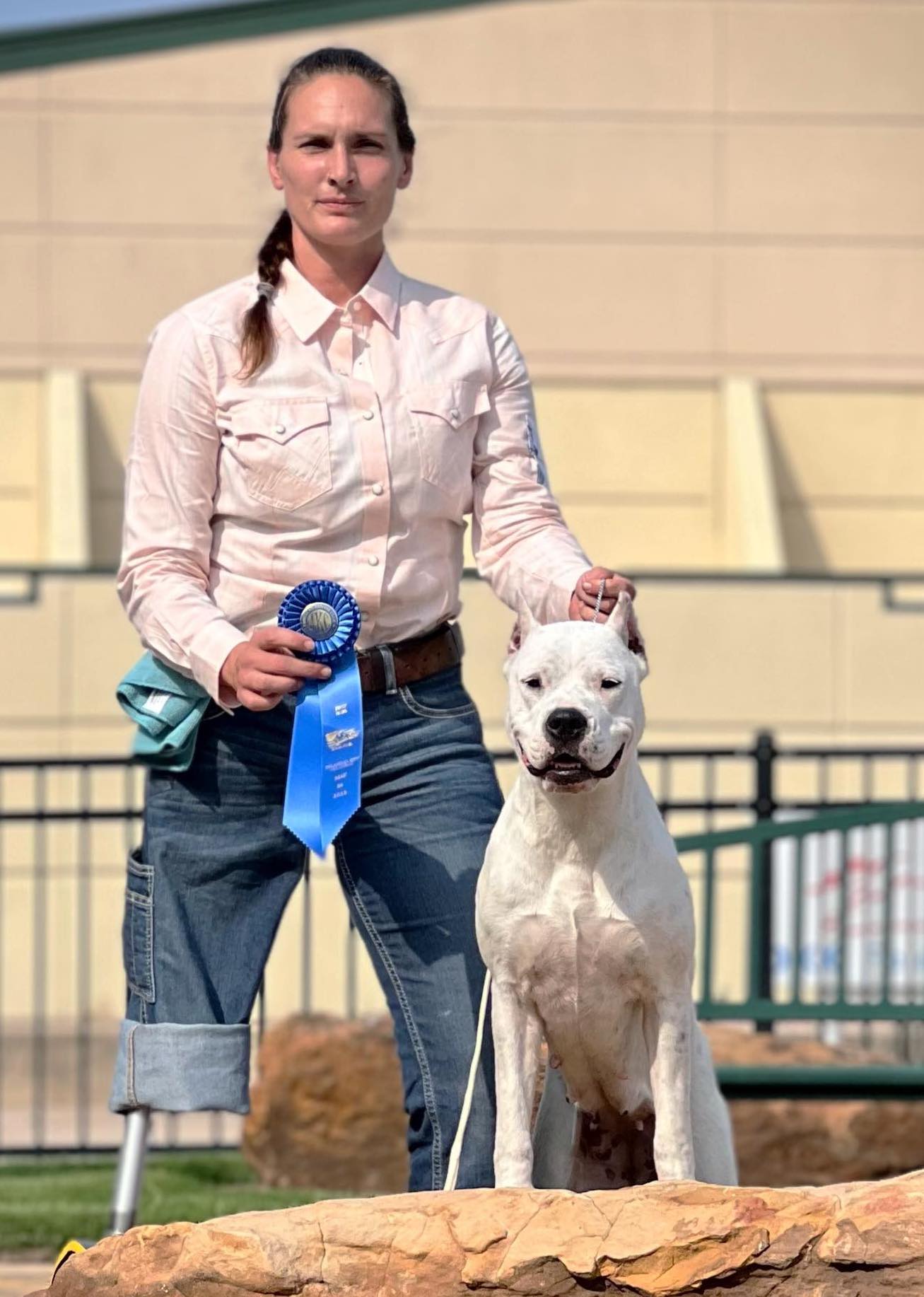
Rebecca Fletcher with her Dogo Argentino.
Rebecca Fletcher joins host Laura Reeves to talk about her journey as a service dog trainer and breeder owner handler of Dogo Argentino, while overcoming extreme obstacles after losing her leg.
Fletcher, a retired Marine, started her journey by training her own Dogo Argentino as her first service dog.
“Don’t give up, but give yourself grace,” Fletcher said. “Grace is absolutely vital. And I wasn’t very good at it. I get mad myself. You know, I train service dogs for disabled people and I tell them all the time, you know, you gotta be patient with yourself. And I give them some great advice. I’m not always good at taking my own advice.
“I got my first Group One under Doctor Keating. And it meant so much to me because I was on the verge of not willing to do this anymore. I don’t know if he’ll ever know how much it meant to me to actually be in his ring and have a dog that I love so much be awarded. But it was amazing.
“I didn’t know anybody in the dog show world really. And it was a process, but a lot of people were very, very welcoming and guiding me. It’s been a great learning process of figuring out how I can be in the ring with my disability. And again, advocating for yourself, you know, the AKC is not exempt from providing reasonable accommodations to us.
“I hope to continue inspiring people to get out there and try and do whatever they can do. My goal is to help inspire other people to overcome their challenges and keep going.
“We all have challenges and how we face those challenges I think is what makes all the difference.”
676 – Brucellosis or CHV? Deadly Diseases for Puppies
Brucellosis or CHV? Deadly Diseases for Puppies
Dr. Marty Greer joins host Laura Reeves for a Veterinary Voice topic that can be devastating for breeders and deadly for puppies. Brucellosis and CHV (Canine Herpes Virus) can both decimate a litter.
“If you lose even a single puppy in a litter, have testing done on that puppy,” Greer said. “Have a necropsy done of some form at your vet clinic or at a referral center or at a reference lab, so that you find out what happened because you can’t learn from it if you bury your mistakes. You can’t learn anything and you can’t move your breeding program forward until you know what happened.
“There is no diagnosis of fadubg puppy syndrome. So if your vet says that’s what you have, you need to find another vet or dig a little harder with the one you’re working with. Because you need to find out what happened.
“Brucellosis hasn’t gone away. There’s no vaccine for it. So yes, you can have anything from a normal looking bitch and a normal looking stud dog to a stud dog that has inflamed testicles. You can see normal adult dogs develop brucellosis symptoms.
“These can be uveitis, which is inflammation of the eye. They can be disco spondylitis, which is inflammation of a disc. So if you go in for a diagnosis at your vet clinic and you have certain symptoms, even in a normal dog that isn’t a breeding dog they may test for brucellosis because it can cause other diseases.
“In bitches we can see anything from apparent infertility where she looks like she didn’t conceive but she actually conceived and lost the litter, to puppies that are born weak that died shortly thereafter, puppies that are born normal and die afterwards, bitches that have infertility. It is shared through venereal spread, which is male to female breeding, but it can be spread through any body fluid. So urine, placentas, all those things.
“Brucellosis survives freezing semen, so it doesn’t even get killed at that -300° that we see semen frozen at. So you need to be aware that when we say you should test for brucellosis, we’re not joking around. You should test for brucellosis.”
Listen in for more information. Learn more about USDA approved brucellosis testing HERE.
675 – “Each puppy is another little sketch” – Liz Hansen and Sketchbook
“Each puppy is another little sketch” – Liz Hansen and Sketchbook
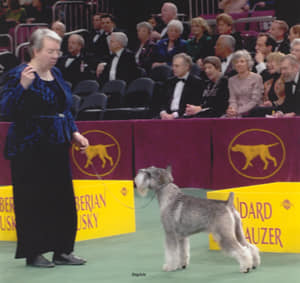
Liz Hansen with Seasar at WKC.
Host Laura Reeves is joined by Liz Hansen, Sketchbook Standard Schnauzers, AKC’s Breeder of the Year nominee for the working group.
With a degree from the University of Minnesota in scientific illustration, Hansen named her breeding program Sketchbook.
“Sketchbook came just sort of naturally from that because these are little sketches I make. Each little puppy is another little sketch,” Hansen said.
“Almost 26 years ago, another breeder and I ran into a problem. We had epilepsy show up in our lines that were related and went looking for somebody to help us keep the good and get rid of this problem. And we were at a show in Columbia, MO, and went and talked to Gary Johnson at the university. And after about a year of bringing him samples and getting other clubs involved and helping to write grants and all this kind of stuff, he said, ‘You know, you just need to come work for me, so I changed jobs over epilepsy.
(Listen to Liz’ conversation with Laura about this project from 2017!)

Standard Schnauzers compete in herding competitions.
“That’s good people that I gave a good dog, just like my sister and I got a great dog to start with. I try to coach people along.”
“I like to coach the people that get my dogs,” Hansen said. “We’ve got over 200 champions and most of those are standard schnauzers and well over 250 performance titles on the standard Schnauzers. And that’s not all me. That’s good people that I gave a good dog, just like my sister and I got a great dog to start with. I try to coach people along.”
674 – Irish Wolfhounds: Soulful Gentle Giants
Irish Wolfhounds: Soulful Gentle Giants
Love the Breeds returns as host Laura Reeves talks with Jamie Souza Bartlett about Irish Wolfhounds, the gentle giants of the dog world.
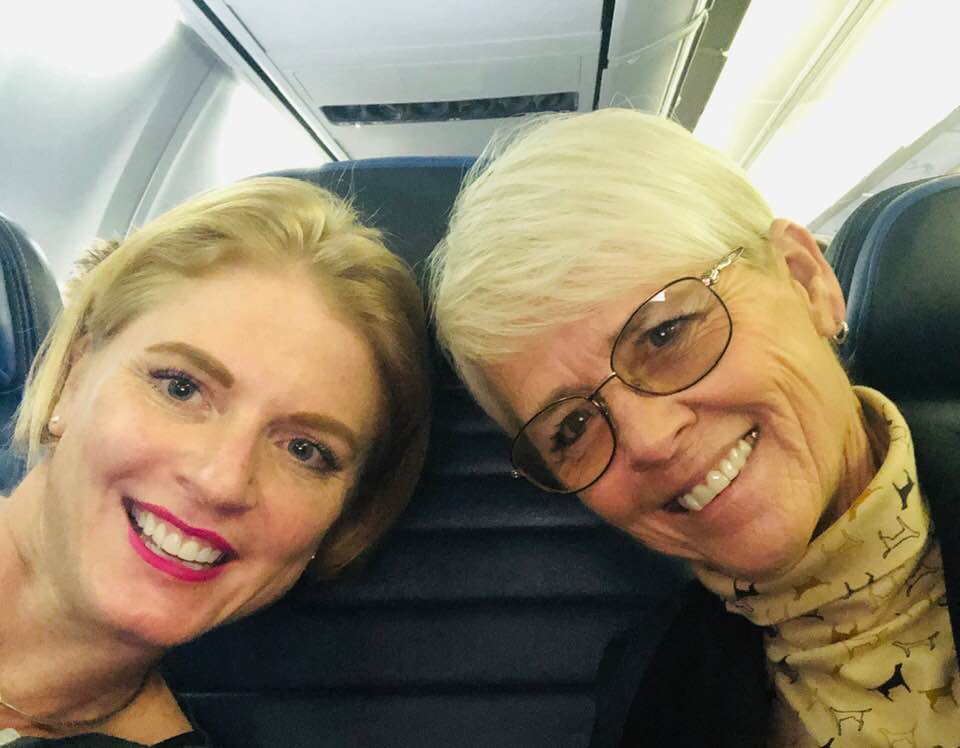
Jamie grew up with Irish Wolfhounds with her mom, Linda Souza.
“They’re just, they’re soulful, they’re sweet. They’re the gentle giants and I was very, very fortunate to grow up with them,” Jamie says.
“Wolfhounds, much like a lot of breeds, were bred for a specific purpose, which was to hunt wolves in Ireland. Eventually, the wolves became extinct in Ireland, and consequently the wolfhounds almost became extinct. And then several years later Captain Graham came along and really found that this was a breed that required rejuvenation and real, real rescuing and bringing back because they’re just so wonderful.
“You don’t own wolfhounds, you’re owned by them. It’s not an easy breed to have by any means. It comes with its own set of issues. But when you do own them and you’re owned by them, there’s just really no greater thing in the world. They are so soulful and so wonderful and like, you become part wolfhound.
Feeding
“As a young dog, they eat quite a bit because you’re looking at a puppy that is a pound when it’s born and it’ll be 100 pounds by the time it’s six months old. So the growth rate is very rapid and they do eat quite a bit as babies. And then quite quickly, once they kind of reach their full height it curbs significantly because you’re not looking at a dog that’s like a Doberman or something that’s constantly pacing, constantly moving around. They will have bursts of energy. Big burst of energy in the morning, big burst of energy when it gets cold at night, and the rest of the time they’re chilling. So they really don’t eat as much as an adult as one would think, considering their size.

Puppies in the breed grow fast!
“I always encourage anybody to listen to their breeder and their breeding program because different lines tend to evolve differently and grow at different rates. We were always just really careful. We wanted them off of puppy food and anything that was promoting rapid growth as quickly as possible. We’re trying to do things that are keeping them from growing too fast, which is kind of like the opposite of what a lot of other people do or they want them to like beef up. Really, that’s absolutely what we don’t want to do.
Exercise
“We also have a lot of protocols, not just around food, but around exercise. And we tell all of our new puppy buyers like you have to be very, very careful with this breed as they’re growing up. And again, the inclination is like, ‘ohh, I got a puppy and I want it to go run around and play with my other dogs and I want it to be jumping around and being goofy’ and it’s just a hard no.
“Until these dogs’ growth plates close you can do really, really irreparable damage and we tell people don’t take them into the hotel rooms and let them jump on the beds and jump down, you don’t want all that impact on them as they’re growing. Once they hit that two year old range then we’ll start putting them out carefully with other dogs. It was one of the great things actually about having whippets. My whippets are fantastic exercising our wolfhound puppies, right, because there was no to low impact, but it helped with their movement. They’re running, but kept them developmentally in a good place where they weren’t getting injuries to the shoulders or elbows or anything else.”
673 – Maripi Wooldridge on How to Make Your Dog a Winner
Maripi Wooldridge on How to Make Your Dog a Winner
Host Laura Reeves is joined by Maripi Wooldridge, handler of the 1995 Westminster Kennel Club Best in Show winning Scottish Terrier, Ch. Gaelforce Postscript. More recently, Maripi’s Lakeland Terrier MM won the group here in 2022. Maripi takes us through how she thinks about making a dog a winner.
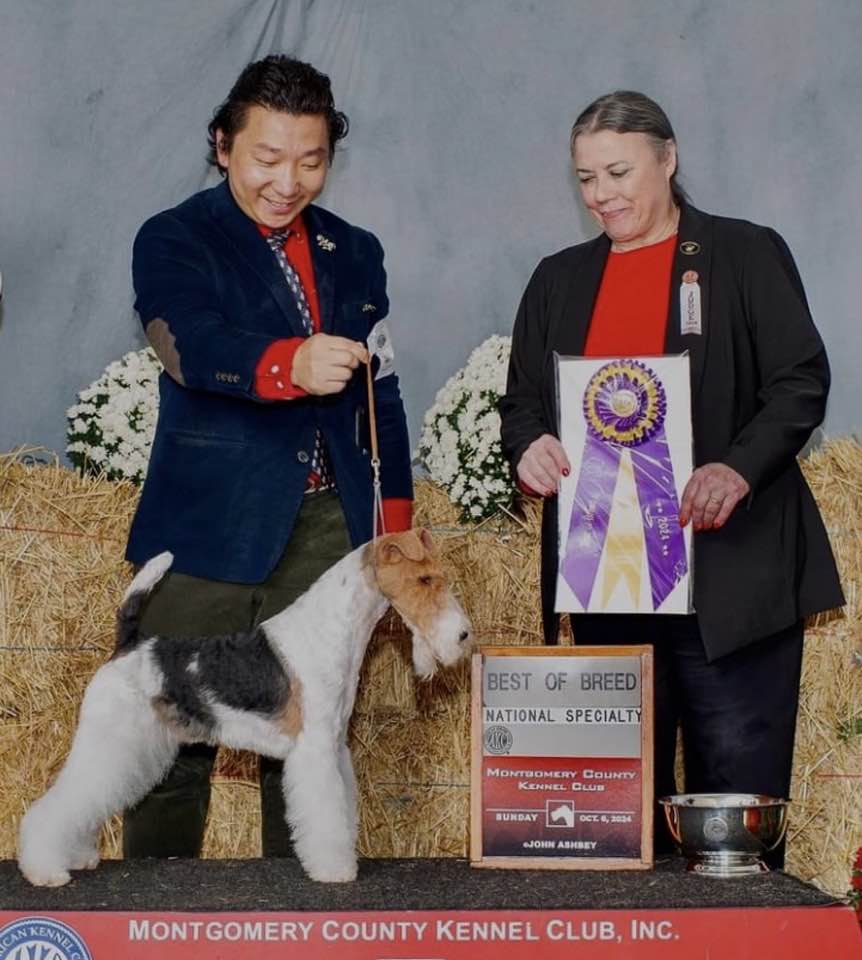
Maripi Wooldridge judging the 2024 Wire Fox Terrier National Specialty show.
LR: If you want your dog to always be best in show ready? Any breed, what are your three top tips?
MW: Conditioning both mental and physical. They have to be fed right, exercised right. Mentally, they have to be treated like they’re best in show dogs so they know it. I think you always have to start out with a good dog and people think that ‘oh good enough is good enough’ and good enough is just not good enough.
A lot of people do some winning with “good enough” but to really have a top dog you have to have good ones and you have to manage them right. You have to manage how you go to dog shows, where you go to dog shows, and have a good relationship with your clients. Nowadays, there are way fewer good clients and money clients that can afford to do this business.
LR: Treat it like a best in show dog. What does that mean to you? What does that look like to you?
MW: Well, as far as my breeding program, I bring every puppy up like if it’s going to be a good one. I think most good breeders and successful breeders do that. Anybody that can pick a puppy at eight weeks and put their mortgage on it, they’re way better than me.
But when you get them in as a handler, they have to feel special. They have to feel special over the class dogs that are gonna go home in a month and a half. They have to have things whether it’s walks, whether it’s put on the table every day, and even if you just brush their coats or clean their coats or pet ’em, so that they know they are special. Bring them in last instead of first, so that they are the big dogs around. I mean, little things that mean a lot to the dogs that people don’t even think about. First out in the morning, that’s very big if you want a dog to feel special.
It makes a huge difference, especially with the smart breeds. I mean, there’s some dogs that doesn’t really matter, they’re fine, I’m here. But with breeds that are clever and smart, you have to bend over backwards.
I had an assistant when I was showing Peggy Sue that would go in the crate room in the middle of the night with a flashlight to look into her crate to see how she was laying because she would wake up in the morning and have like a little wrinkle on the side of her coat. So she made bedding so that she would not get that little wrinkle on the side of her thigh. That level of attention is absolutely needed for a dog to give you everything they have.
The second half of the episode is available for Patrons Only. Subscribe at https://puredogtalk.com/patron/to hear more from Maripi’s decades of insight.
672 – Lumps and Bumps: From Benign to Bad
Lumps and Bumps: From Benign to Bad
Dr. Marty Greer joins host Laura Reeves for a deep dive on the various lumps and bumps we see on our dogs, from benign to bad, from histiocytomas to osteosarcoma.
“Histiocytomas are really, really common. And they are really scary looking because there are these pink bumps that show up on young dogs and they come seemingly out of nowhere. It’s usually on the head, neck or on the feet, the front legs. You’re gonna be afraid that it’s something like a mast cell tumor. And mast cell tumors are bad, terrible, bad tumors. But histiocytomas are almost always in young dogs … if it’s an older dog, it’s more likely to be a mast cell tumor and not necessarily benign.
A chance to cut, a chance to cure
“And people are always under the impression that if you take (a lump) off that you’re going to make it spread or it’s going to be bad faster. And the answer is really that’s not the case. You need to go in, take it off, take good enough margins that it’s not likely to come back. But there are some masses that have little finger -like projections. And no matter how careful the surgeon is, they can sometimes be recurrent. And there’s kind of two kinds of serious masses. They’re the kind that are locally invasive and are likely to come back, but they’re not going to metastasize to other organs like the lung, like the liver, other things like that. And then there’s the bad ones that they’re just gonna spread.”
Listen in to the full episode for a complete rundown on everything from sebaceous cysts and lipomas to mast cell tumors and osteosarcoma, how to differentiate them, treat them and when to see your vet.
Marty’s pro tip is to be sure to physically locate and mark the specific lump or bump in question on the dog before visiting the vet. While generally not an emergency, various lumps and bumps should be evaluated clinically.
671 – Beagles! Phenomenal Little Hounds for Families
Beagles! Phenomenal Little Hounds for Families
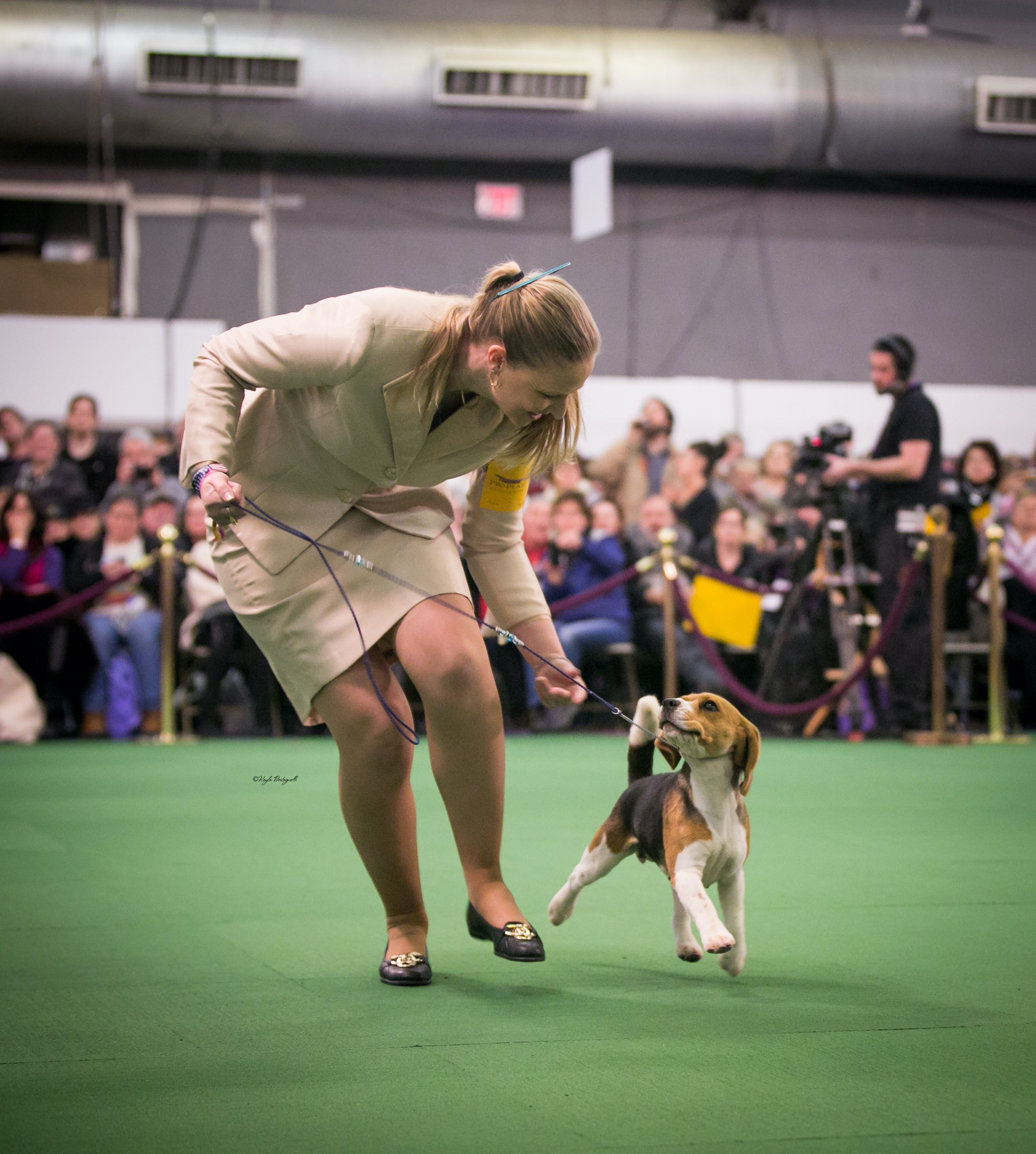
Lindsay Bryson showing her Beagle at Westminster Kennel Club.
Host Laura Reeves is joined by Beagle breeder Lindsay Bryson for a deep dive on Beagles as we ramp up the Love the Breeds specials again.
Lindsay started her Beagle journey with an obedience dog and shares why that challenge helped her understand the breed better.
“I decided to really jump into the dog world with the biggest challenge I could find,” Lindsay said. “He was not even supposed to be a show dog. I had no interest in doing conformation shows. I just wanted to do something with my dog and this woman that I got my first Beagle from, she was in obedience and I thought, well that sounds like fun.
“I took him to the pet store one day and the cashier there said, wow, you have a really beautiful Beagle, you should show him in conformation. And I thought, ohh, why not? We’ll give that a try too. Sure. So that is how I fell down the rabbit hole, for lack of a better term, of conformation dog shows.
“I teach my dogs a quiet command very, very early. You do actually, technically want a loud Beagle because if you’re out in the field, you essentially send your pack out and you don’t see them, you are focusing on hearing them. So if you have a quiet Beagle that doesn’t open up and bay when they catch the scent, you’re gonna lose it. It’s going to be gone. And many people know that Beagles, once they get going, they’re not necessarily going to come back. So you need to have a loud Beagle.
“If you’re going to be taking that into your home and living with it. obviously, you don’t want that. So one of the things that I teach my dogs very, very early is ‘quiet,’ knock it off, you know, keep your volume down. Because that is what’s going to work in neighborhoods and when you have people living around you versus out in the field or on acreage.
“Living with beagles is like having a permanent 2 year old. They are just forever toddlers. They’re constantly looking for things, they’re looking for stuff to get into. They’re looking for ways to occupy their mind. It is so important to keep a Beagle’s mind busy. Because as soon as they get bored, that’s when you start running into the problems that people talk about. Digging, barking, destructive behavior, separation anxiety.
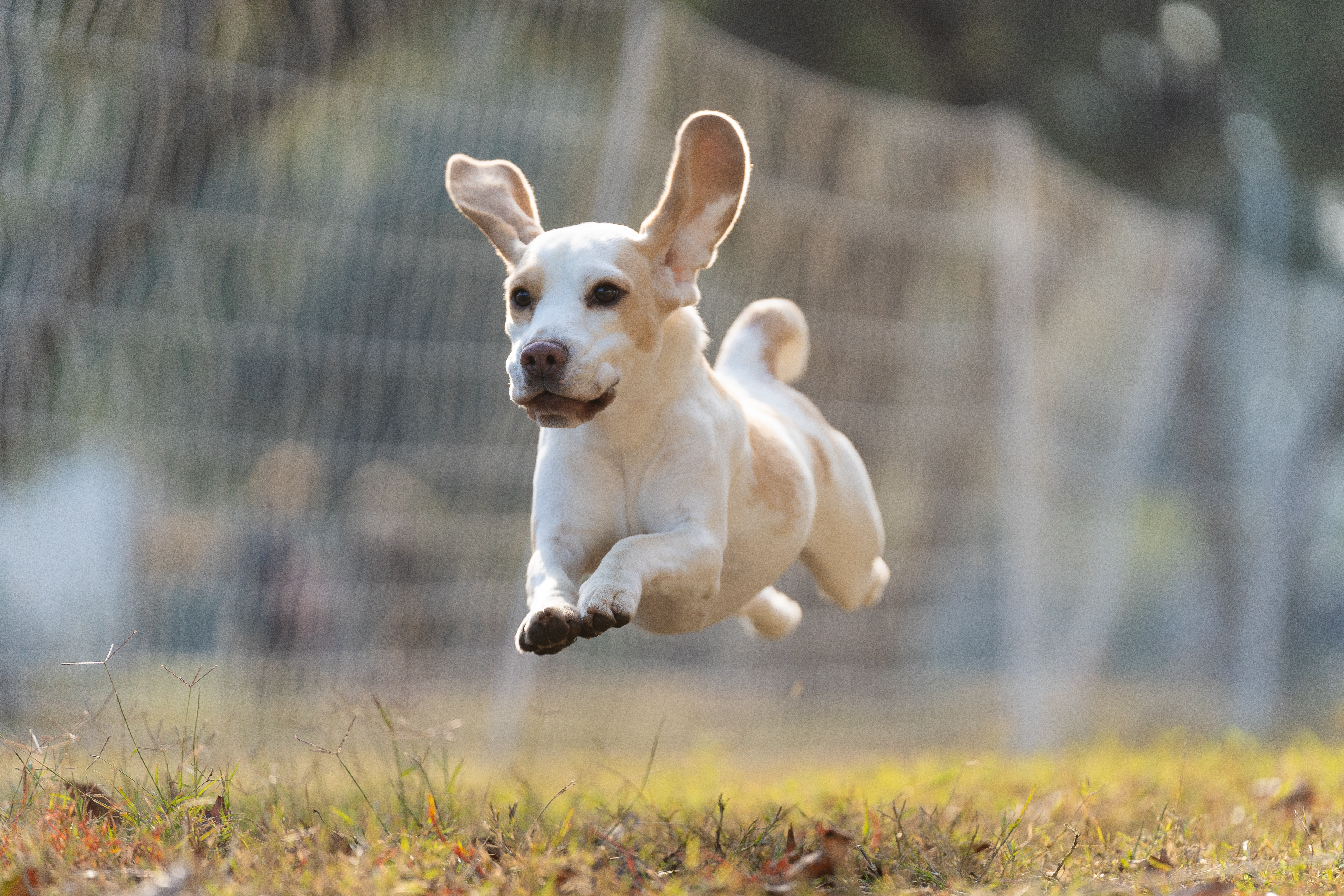
Beagles love FASTCat
“If you have a tired Beagle, it is a happy Beagle. So I always encourage people to go out and do things with their dogs, take them hiking, take them running, you know, do performance work with them, even if it’s not obedience. I’ve started running my dogs in Fast Cat and they love it. They think that is the greatest thing because all they get to do is run for 100 yards and then they get cookies at the end. It’s like the perfect Beagle job.”
670 – Emergency Medicine Best Practices
Emergency Medicine Best Practices
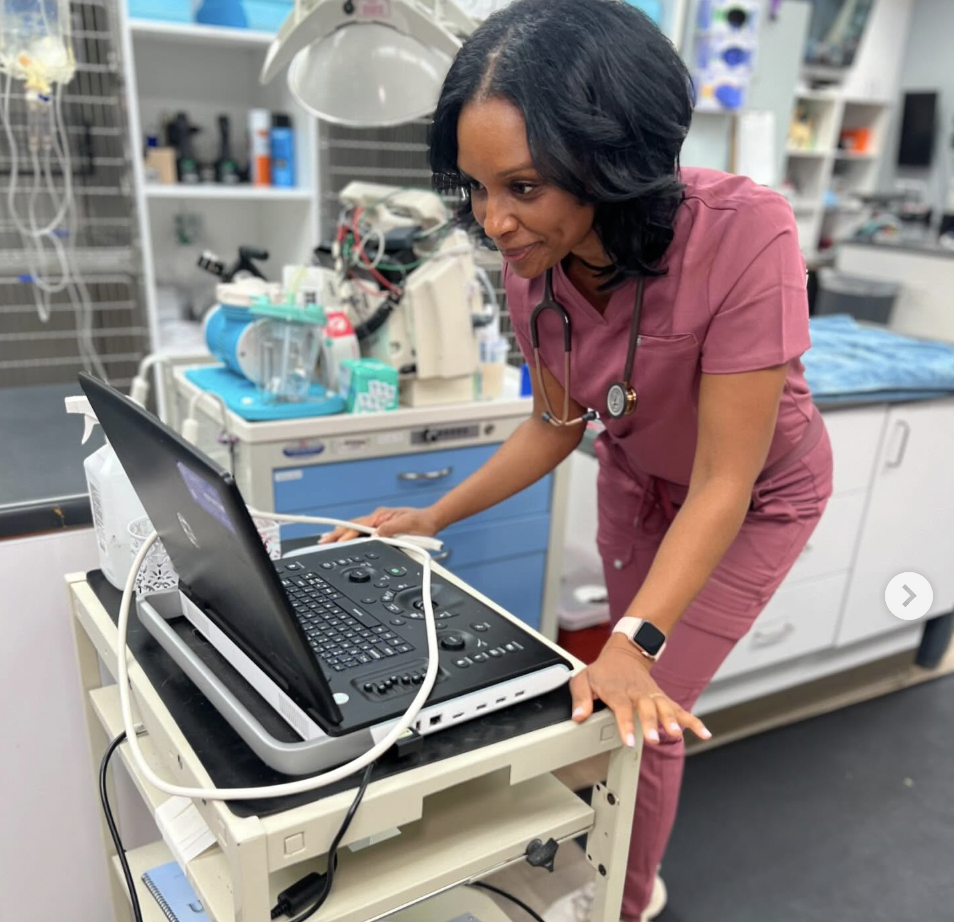
Dr. Callie Harris at her “day job” in emergency medicine.
Dr. Callie Harris joins host Laura Reeves for a deep dive on emergency medicine, urgent care and which is right for you and your dog.
“I got bit by the emergency bug,” Dr. Callie said. “This is when the magic started to happen, where I recognize I was an adrenaline junkie. I loved working with really scary crazy cases and I also enjoyed being part of the entire team in my exam room. With very frantic scared pet parents, I knew that I could provide not only life saving techniques, but communication strategies to try to promote calm.
“This is what I tell that next generation of aspiring veterinary professionals, animal welfare professionals, anybody in the pet care industry, pets are attached to humans. They kind of have to be prepared to talk to other people because my patients, they don’t get in their own cars, they don’t drive to the practice, they don’t fill out their own history forms. Guess who has to do that? The pet parent. So it’s a whole thing.
“At the end of the day, I have seen any and everything. Emergency veterinarians, we’re definitely like the Cowboys of our profession or Cowgirls or cow people, where nothing phases us. We will eat while we’re looking at a really gross wound. We can just get through anything.
“The development of emergency facilities came about and so now you have practices that are just dedicated to seeing your non vaccines preventative Wellness types of appointments. We’re really seeing the sick patients but even then, ER’s became over inundated with cases, pet ownership skyrocketed.
“So over the past handful of years is really when we started to see the uptick in urgent cares in the vets space. And so an urgent care is going to provide that middleman if you will. So this is going to be the facility that’s going to still treat those ear infections, UTI’s, vomiting and diarrhea, coughing, you know, your standard, “my pet is sick on a weekend or after hours and I don’t know what to do.’
“The reason why you would bypass an urgent care is for those real critical scenarios such as my pet’s unable to breathe or my pet is bleeding out profusely, my pet got hit by a car, my pet has a really severe fracture. These are going to be the ones that I would urge pet parents to drive past the urgent care and go to an emergency.”
Listen to the full episode to hear Dr. Callie’s adventure with Moon Pie the goat and more.
669 – How to Climb the Mountain to Owner Handled Success
How to Climb the Mountain to Owner Handled Success
Antoinelle Vulpis joins host Laura Reeves to discuss how she climbed to the pinnacle of owner handled success, winning Best in Show at Montgomery Kennel Club with her Skye Terrier.
Vulpis discussed the beginning of this journey in an episode with Laura five years ago. Today’s conversation brings the story full circle.
“After our big win at Kennel Club of Philadelphia, I was thinking, we got some awesome momentum,” Vulpis said. “We got two more best in show after I spoke with you. I was like, this is incredible. And then the pandemic hit, so all that momentum and excitement just went away for me. For everyone, you know, it was just kind of a weird time. And then when we were lucky enough to have shows again, trying to pick that back up and make people believe again is kind of tough. So it was a little of a unique experience in that.
“Then (I) realiz(ed) that I have these goals in mind, just these little things that I want to check off my checklist. I want to show him at my national. As a veteran. That was a goal of mine and that’s what our whole plan was to do. And then I went to Canada too. I was like, let me get his Canadian Championship. Go to Canada with my girlfriends, have a girls weekend and try to get a title. So yeah, I literally only showed him in June (2024) to finish his Canadian title and then Montgomery.
…if the judge can’t see it, it doesn’t matter…
“(In Best in Show) we’re showing to Lydia Coleman Hutchinson, the legend. I’ve shown to her several times throughout my dog’s career, maybe half a dozen times. But just to be in the ring and like to put my dog on the table as you know, a 7 1/2 year old dog, like just knowing that she’s seen him as a puppy, it was very emotional for me and I just kept on being like ‘Don’t cry. Don’t cry.’
“It’s just such a full circle moment. And I felt so fortunate to just be in her ring again at this stage because this is going to be my last time showing him at the National.
“(On his down and back) I took a knee, man. I mean, it was my Hail Mary. It was the last move, the last card that I had in my deck. So I just got down and just tried to manipulate the lead a little bit and to get him to react to me. And just to see like, ohh, mom is eye level, that kind of thing. And so if you get that, you can get the ears to react a little bit and just let him show off that beautiful top line and his long neck. So you just want him to just for a brief second show off these qualities that we know he has. But you know the answer right? I know my dog has it, but if the judge can’t see it, it doesn’t matter.”
To hear all of Vulpis’ tips and tricks, listen in to the podcast today…
668 – Pro Tips on Raising Orphaned Puppies
Pro Tips on Raising Orphaned Puppies
Dr. Marty Greer joins host Laura Reeves to discuss how to raise orphaned puppies. How to help dams not reject their puppies, increase milk production and deal with mastitis are all covered.
Pro tip number one is avoid having orphaned puppies, Greer notes. Increasing the dam’s calcium intake, using Adaptil collars and saving placental fluid after a Csection are on Greer’s list of ways to encourage the dam’s maternal instinct to kick in.
Pro tip number two is helping dams increase their milk production.
“I don’t know what there is magical about a Bratwurst, if it’s the fat, if it’s the salt, and I’m sure there’s other things as well, but that’s what I’ve had great success with. It helps them to eat better. It helps them to lactate better. The things that people use on the human side for lactation nurses are oatmeal and vegetables like sweet potatoes. So those are some things that you can do and they’ll eat those sometimes when they won’t eat their regular dog food.
“But whatever you have to do to get them to eat, jump through hoops to make it happen. Because if she is eating and drinking, then you don’t have to feed the puppies nearly as much. So you feed the machine that feeds the puppies.
“Now the other things that help. Are fenugreek and that is in the Oxy Mama product that Revival has for improving lactation. And then Reglan which is metoclopramide, a prescription drug that you can get from your veterinary clinic. And one of the side effects is that it improves lactation.
“So fenugreek and reglan make milk and oxytocin lets the milk be released from the glands so they work complementary to each other neither one replaces the other.”
Pro tip number three regards mastitis.
“I don’t wean puppies unless the bitch is really, really sick or there’s a giant necrotic opening in a gland. I will typically let the bitch still nurse her puppies because the amount of antibiotic coming through the milk is infinitesimally small.
“First of all, let’s talk about preventing mastitis. That means bathe her with a Chlorhexidine shampoo 3 or 4 days before she has puppies. So she goes into this clean. Don’t let her go out in the mud or herd your sheep into the trailer when she’s got newborns. And put her on a probiotic because that’s going to all reduce the risk of her developing mastitis.
“If she ends up with mastitis, make sure she gets enough fluids. She needs to be on an appropriate antibiotic and I put them on pain medication to bring down the fever, to reduce the inflammation and that again is safe for the bitch to take and still have the puppies nurse. There’s not enough that gets into the milk, but it’s going to hurt the puppies.
“It’s not just milk, it’s maternal skills as well. She’s licking the puppies, she’s stimulating the puppies, she’s treating the puppies the way puppies need to be treated. No amount of human hand-raising can substitute for that. I know we do our best but it’s still always best for a bitch to be with her puppies than it is to be separated if there’s any possibility of making that happen.”

